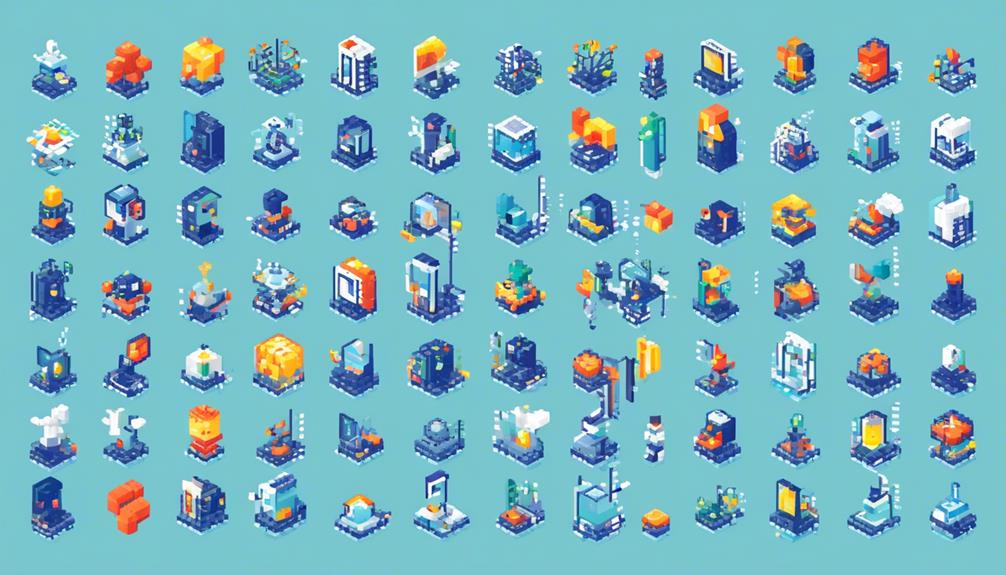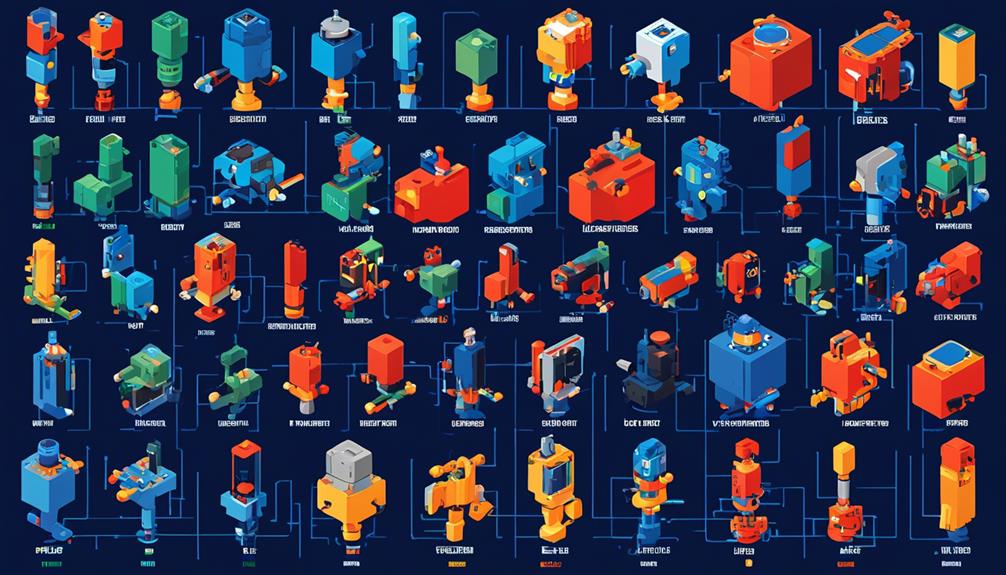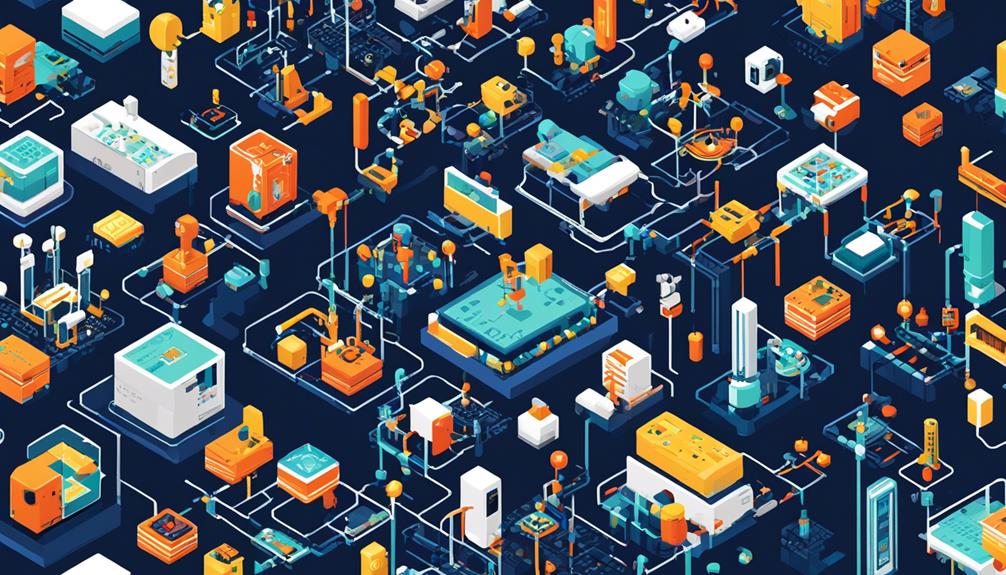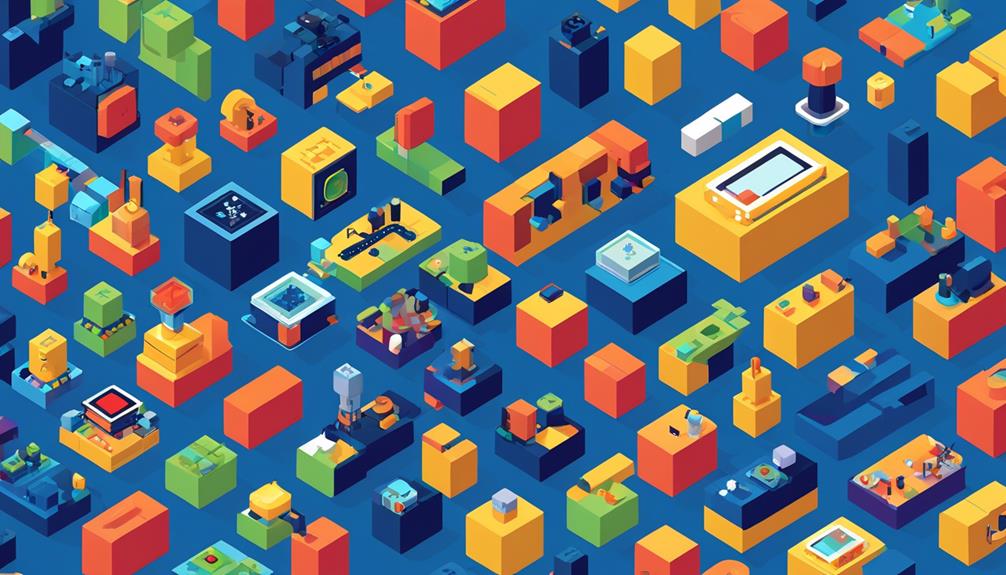In the rapidly evolving world of the Internet of Things (IoT), sensors and actuators play a crucial role in enabling the seamless communication and interaction between devices and the physical world.
These small yet powerful components are the backbone of IoT devices, facilitating the collection of data and the execution of actions based on that data.
From temperature and motion sensors to gas and pH sensors, a wide array of sensor types are utilized in various applications, ranging from environmental monitoring to industrial automation.
Similarly, actuators such as motors, valves, and relays enable IoT devices to respond to the collected data by initiating physical actions.
This guide delves into the different types of IoT sensors and actuators, their applications, the interactions between them, and their integration into IoT devices.
Join us as we explore the exciting world of IoT sensors and actuators and uncover the future trends that hold immense potential for this field.
Key Takeaways
- IoT sensors play a crucial role in collecting real-time data on various environmental factors, electrical measurements, motion detection, pressure changes, and flow rates.
- IoT actuators are responsible for physical responses and interactions with the physical world, enabling tasks such as temperature regulation, linear and rotary motion, and precise control in different applications.
- The integration and connectivity of sensors and actuators in IoT devices allow for seamless data collection, automated physical responses, and the ability to make real-time decisions.
- Advancements in standardized protocols, nanotechnology, edge computing, and distributed intelligence contribute to the evolution of IoT sensors and actuators, enabling compatibility, smaller and more precise components, local data processing, and increased efficiency in various industries like smart cities, healthcare, manufacturing, and agriculture.
Types of IoT Sensors

The varied landscape of IoT sensors encompasses a wide range of physical aspects, including temperature, motion, and more. These sensors play a crucial role in collecting data from the physical world and transmitting it to smart devices connected to the Internet. There are various types of IoT sensors available, each designed to measure specific physical quantities in different environments.
One common type of IoT sensor is the environmental sensor. These sensors are used to measure parameters such as temperature, humidity, air quality, and light intensity. They are often employed in industrial settings to monitor and maintain optimal conditions for manufacturing processes. For example, in a food processing facility, environmental sensors can help ensure that the temperature and humidity levels are within the required range to prevent spoilage.
Another type of IoT sensor is the electrical sensor. These sensors are used to measure electrical properties such as current, voltage, and power consumption. They find applications in energy monitoring and management systems, where they help track energy consumption and identify areas for optimization. Electrical sensors are also used in smart buildings to monitor the usage of electricity and ensure efficient energy utilization.
In addition to environmental and electrical sensors, there are many other types of IoT sensors available. These include motion sensors, pressure sensors, flow sensors, and photoelectric sensors. Each of these sensors serves a specific purpose and is designed to measure a particular physical quantity.
Applications of IoT Sensors
IoT sensors play a crucial role in various industries, collecting data from the environment and enabling smart devices to make informed decisions and perform physical tasks. These sensors, when integrated into IoT systems, provide valuable insights that help improve control and monitoring of environmental conditions.
Here are three applications of IoT sensors:
- Manufacturing: IoT sensors are widely used in manufacturing to optimize production processes and improve efficiency. By collecting data on equipment performance, temperature, and humidity, these sensors enable real-time monitoring and preventive maintenance. For example, temperature sensors ensure that machines operate within optimal conditions, preventing overheating and potential breakdowns.
- Agriculture: IoT sensors are revolutionizing the agriculture industry by enabling precision farming techniques. Sensors such as moisture sensors help farmers monitor soil moisture levels and optimize irrigation schedules, leading to water conservation and increased crop yield. Additionally, sensors can monitor environmental factors like temperature and humidity, helping farmers create ideal growing conditions and prevent crop diseases.
- Weather Reporting Systems: IoT sensors are extensively used in weather reporting systems to collect and analyze data on temperature, humidity, wind speed, and atmospheric pressure. These sensors enable accurate weather predictions and provide valuable information for disaster management and climate research. For example, temperature sensors placed in various locations can help identify heatwaves or cold fronts, allowing authorities to take appropriate measures to protect public health.
Different Types of Actuators

There are various types of actuators that are utilized in different industries for converting energy into mechanical motion. These actuators play a crucial role in the functioning of IoT systems, working in conjunction with sensors to enable automation and control.
One type of actuator commonly used in industrial automation is the pneumatic actuator. These actuators use compressed air to generate linear or rotary motion, making them ideal for valve control applications. Pneumatic actuators are known for their simplicity, reliability, and fast response times.
Another widely used type of actuator is the electric actuator. These actuators convert electrical energy into mechanical motion, offering precise control and positioning capabilities. Electric actuators are commonly found in various industrial applications, such as robotics, manufacturing, and automotive systems.
Thermal actuators are another type of actuator that finds applications in different industries. These actuators produce linear motion in response to temperature changes. They are often used in HVAC systems, where they help regulate the flow of air or fluids based on temperature fluctuations.
In addition to these, there are hydraulic actuators, which convert hydraulic energy into useful work. These actuators are commonly used in hydraulic control systems, offering high force capabilities and precise control over linear and rotary motion.
Lastly, magnetic actuators utilize microelectromechanical systems (MEMS) to convert electric current into mechanical output. These actuators are used in a wide range of industries, including aerospace, automotive, and consumer electronics.
Applications of Actuators in IoT
Actuators play a crucial role in IoT by enabling physical tasks and movements based on sensor data.
In the context of smart homes, actuators are utilized for various applications such as controlling heating and cooling systems, opening and closing doors and windows, and adjusting lighting levels.
These actuators enhance automation and improve energy efficiency, providing convenience and comfort to users in their everyday lives.
Role of Actuators
Actuators serve a crucial role in IoT applications by converting electrical signals into physical actions, allowing for precise control and interaction with the physical world. Here are three applications of actuators in IoT:
- Triggering cooling and heating functions: Actuators are used in IoT devices such as smart thermostats to control the temperature by activating cooling or heating systems based on user settings.
- Opening and closing functions: Actuators enable IoT devices like smart doors or windows to open and close, providing convenience and security for users.
- Performing physical tasks: Actuators are essential for controlling mechanisms in IoT systems. They can be used in applications such as car airbags, hydraulic systems, machines requiring movement, and industrial applications for valves, pumps, and motors.
Actuators in Smart Homes
Smart homes benefit greatly from the use of actuators, as these devices enable automated control of various systems and devices, enhancing convenience, energy efficiency, and security in the IoT environment. Actuators in smart homes are connected to IoT platforms, receiving commands and data from sensors for efficient and responsive automation. These devices can adjust window blinds, open/close doors, and control appliances based on user preferences and environmental conditions. Examples of actuator applications in smart homes include smart thermostats adjusting temperature, smart locks controlling door access, and smart lighting systems adjusting brightness and color. Actuators play a crucial role in enhancing the ease of use and functionality of smart devices, allowing for physical actions to be automated and controlled remotely.
| Actuator Applications in Smart Homes |
|---|
| HVAC system control |
| Lighting system control |
| Security system control |
| Appliance control |
| Door and window control |
Interactions Between Sensors and Actuators

The interactions between sensors and actuators play a crucial role in the seamless functioning of IoT devices, allowing for the conversion of environmental conditions into physical actions. In an IoT system, sensors collect data from the environment and convert it into electrical signals. These signals are then processed by the actuators, which perform physical tasks based on the information received from the sensors.
To better understand the interactions between sensors and actuators, consider the following scenarios:
- Linear Motion: A sensor detects the presence of an object and sends an electrical signal to the actuator. The actuator, in response, moves in a linear direction to push or pull the object.
- Rotary Motion: In this case, the sensor detects a change in the environmental conditions and sends an electrical signal to the actuator. The actuator then translates this signal into a rotary motion, allowing it to rotate or turn an object.
- Thermal-Sensitive Material: Sensors equipped with thermal-sensitive material can detect changes in temperature. When the sensor detects a specific temperature threshold, it sends an electrical signal to the actuator. The actuator, based on this signal, can automate the opening or closing of a valve to control the flow of a liquid or gas in an industrial setting.
The interactions between sensors and actuators are vital for automating processes in various industries. By collecting data from the environment and converting it into physical actions, IoT devices can enhance efficiency, reduce human intervention, and improve overall productivity.
Integration of Sensors and Actuators in IoT Devices
The integration of sensors and actuators in IoT devices is crucial for creating a smart system that connects the digital and physical worlds seamlessly.
This interconnection enables IoT devices to collect data from the environment through sensors and convert it into electrical signals, which can then be used by the actuators to perform physical actions or specific tasks.
Sensor-Actuator Interconnection
Sensor-actuator interconnection in IoT devices facilitates the seamless integration of sensors and actuators, enabling real-time data collection and immediate physical response to environmental changes. This interconnection forms the foundation for IoT devices to interact with and manipulate the physical world based on the data collected from the environment.
Here are three examples that illustrate the importance and functionality of sensor-actuator interconnection in IoT systems:
- Linear motion control: By integrating sensors and actuators, IoT devices can automate industrial processes that require precise linear motion. Sensors can detect the position or movement of objects, and actuators can respond by initiating linear motion to perform specific tasks.
- Fluid level control: Sensor-actuator interconnection allows IoT devices to monitor and control the level of fluids, such as water, in tanks or reservoirs. Sensors can measure the fluid level, and actuators can adjust valves or pumps to maintain the desired level.
- Temperature regulation: IoT devices equipped with temperature sensors and thermal-sensitive materials can automatically respond to temperature changes. When the sensor detects a deviation from the desired temperature, the actuator can adjust heating or cooling systems accordingly to maintain optimal conditions.
IoT Device Integration
In the realm of IoT systems, the integration of sensors and actuators in devices plays a crucial role in enabling real-time data collection and automated physical responses to environmental changes. Sensors in IoT devices are responsible for collecting data from the environment, such as temperature changes or fluid levels, while actuators act upon this data to perform specific tasks or control mechanisms.
The integration of sensors and actuators in IoT devices allows for the automation of industrial processes, providing the ability to control and operate systems with precision. Actuators can take various forms, such as magnetic actuators for linear motion or thermal-sensitive materials that respond to temperature differences. By connecting sensors and actuators, IoT devices can analyze data and trigger physical responses, using energy sources such as compressed air or hydraulic fluid.
This integration enables efficient and automated operations in a wide range of industries.
Smart System Connectivity
Smart System Connectivity is a crucial aspect of IoT devices, as it integrates sensors and actuators to enable seamless data collection and physical output. This integration allows sensors to gather data from the environment, while actuators perform specific actions based on the collected data.
By ensuring seamless communication and interaction between sensors and actuators, Smart System Connectivity facilitates decision-making based on real-time data and enables IoT devices to effectively respond to environmental changes. This connectivity plays a vital role in creating autonomous and responsive IoT systems by linking sensor inputs to actuator outputs.
For example, in industrial applications, linear motion actuators can be controlled by sensors to perform precise movements. In energy management, thermal-sensitive materials can trigger actuators to optimize energy usage. In smart cities, data collection from various sensors can be used to control actuators for efficient infrastructure management.
Future Trends in IoT Sensors and Actuators
Future trends in IoT sensors and actuators are poised to revolutionize the field, as advancements in energy efficiency, artificial intelligence, communication protocols, miniaturization, and edge computing pave the way for enhanced capabilities and seamless connectivity. These developments will not only improve the performance of IoT devices but also enable a wide range of applications that can benefit various industries and improve public services.
One of the key areas of focus in the future of IoT sensors and actuators is energy efficiency. As technology continues to evolve, there is a growing emphasis on developing sensors and actuators that consume less power while maintaining high performance. This is crucial for extending the lifespan of battery-operated IoT devices and reducing energy costs in large-scale deployments. Additionally, advancements in energy harvesting techniques, such as solar or kinetic energy, can enable self-powered IoT devices, eliminating the need for external power sources.
The integration of artificial intelligence and machine learning algorithms into IoT sensors and actuators will also play a significant role in shaping the future of this field. By leveraging AI capabilities, these devices can analyze and interpret data in real-time, enabling predictive analytics and autonomous decision-making. This will greatly enhance the efficiency and effectiveness of IoT applications across various domains.
Moreover, the development of advanced communication protocols and standards will facilitate seamless connectivity and interoperability among IoT sensors and actuators. This will enable different devices and systems to communicate and share data efficiently, regardless of the underlying technology or manufacturer. The emergence of standardized protocols, such as MQTT, CoAP, and OPC-UA, will ensure compatibility and interoperability in the increasingly diverse IoT ecosystem.
Furthermore, miniaturization and advancements in nanotechnology will lead to the creation of smaller, more precise IoT sensors and actuators. These devices will be capable of collecting and transmitting data with higher accuracy and in real-time, enabling a wide range of applications in industries such as healthcare, manufacturing, and agriculture.
Lastly, the emergence of edge computing and distributed intelligence will enable IoT sensors and actuators to process data locally, reducing latency and dependency on cloud services. This will be particularly beneficial in applications where real-time decision-making is critical, such as autonomous vehicles, smart cities, and industrial automation.
To illustrate the potential impact of these future trends, the table below provides examples of IoT applications and the corresponding sensors and actuators used:
| IoT Application | Sensors Used | Actuators Used |
|---|---|---|
| Smart City | Air quality sensors, traffic sensors, waste management sensors | Street lighting control, traffic signal control, waste bin sensors |
| Healthcare | Biometric sensors, temperature sensors, motion sensors | Drug dispensing systems, remote patient monitoring devices, prosthetic limbs |
| Manufacturing | Temperature sensors, pressure sensors, vibration sensors | Robotic arms, conveyor systems, automated quality control systems |
| Agriculture | Soil moisture sensors, weather sensors, pest detection sensors | Automated irrigation systems, greenhouse climate control systems, pest control mechanisms |
Frequently Asked Questions
What Are the Sensors and Actuators for Iot?
Sensors and actuators play a crucial role in IoT systems by gathering data from the environment and converting electrical signals into physical actions. Common applications of IoT sensors and actuators include smart homes, industrial automation, and various IoT applications.
Choosing the right sensors and actuators for an IoT project involves considering factors such as the desired functionality and communication protocols. Integrating sensors and actuators in IoT systems can present challenges, but there are solutions available.
Calibration and maintenance of IoT sensors and actuators are important for accurate and reliable data collection. The future of IoT sensors and actuators holds promising advancements and trends, while security considerations are essential to protect sensitive data.
Real-world examples showcase the wide range of applications using sensors and actuators in IoT systems.
What Are the 5 Types of Sensors in Iot?
Temperature monitoring, environmental sensing, motion detection, air quality measurement, and light intensity sensing are five types of sensors commonly used in IoT applications.
For example, in smart homes, temperature sensors can monitor the indoor temperature and adjust the HVAC system accordingly. Environmental sensors can detect changes in humidity and air quality, alerting users to take necessary actions.
Motion sensors can detect movement and trigger security systems. Light sensors can adjust lighting levels based on natural light intensity.
These sensors enable efficient and automated control in various IoT scenarios.
What Is Iot for Beginners?
Understanding the basics of IoT technology is crucial for beginners. IoT refers to the interconnection of physical devices through wired and wireless networks. It has the potential to transform industries and businesses by collecting and analyzing data from various sources. However, it also poses security and privacy challenges that need to be addressed.
Choosing the right IoT platform and understanding IoT standards and protocols are important for successful deployments. Cloud computing plays a vital role in storing and processing IoT data.
Exploring the future advancements of IoT is essential for staying ahead in this rapidly evolving field.
What Is the Acceptance Rate for Sensors and Actuators a Physical?
The acceptance rate for sensors and actuators in physical applications varies depending on several factors such as the specific industry, application requirements, and technological advancements.
However, the increasing adoption of IoT devices and advancements in sensor and actuator technologies have significantly impacted environmental monitoring, smart cities infrastructure, industrial automation, healthcare, autonomous vehicles, precision agriculture, and more.
Challenges and opportunities in sensor miniaturization, sensor calibration for accurate data collection, and security considerations for IoT sensors and actuators are important aspects to consider in the acceptance and integration of these technologies.
